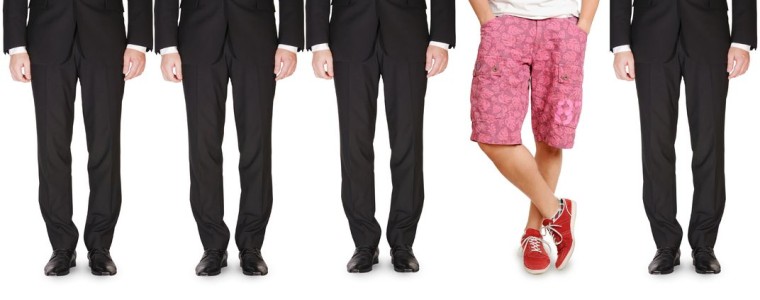What to wear, what not to wear
Going in front of people to make a presentation means asking them to give up their time and attention. If you want to increase your chances of success, you’ll start by turning your attention to how you present yourself. And even if these seem like more casual times, trust me: People are still judging a lot about you by what you wear. So, where do you start?
The rule of thumb is that you should always dress a notch better than you think your audience will be dressed. You can always dress it down once you get there if you feel uncomfortable. For example, you can always take off your suit jacket or roll up your sleeves if it seems like a relaxed crowd and you want to avoid looking formal. But if you come to a suit-and-tie affair in jeans, there’s no way to save it.
Think ahead about the speaking setting and who your audience is. For legal professionals, for example, you will always wear a business suit in the courtroom. Not business casual, not a sports jacket, not a dress that could be worn out to a club – a business suit. From that starting point, you may need to assess just how well you dress — overdo it, and the jury might perceive you as too slick; underdress and you may tell the judge and your client that you don’t care.
If it is a business presentation, a business suit is appropriate. If you are at a business or community function, you may wear khakis and a nice shirt or blouse. If you are speaking to a group of high school or college kids you want to dress it down so you are not intimidating, or worse, boring. Geography and local culture may even play a part: If you’re in Hawaii, your dress may likely be more casual, even at a business event, than in New York or Los Angeles.
A cautionary tale about flip-flops
If you are tempted to dress casual because you are super-successful and you don’t care, or you don’t think your audience cares, think again. They do care and they will judge you – even if you’re Barbara Walters or David Bois. A friend of mine recently told me about a colleague who is extremely well known in the legal community — well respected and seen as a the “go-to-guy” regarding his emerging field of expertise. This power-player — we’ll call him John — gives talks all over the country at legal events. He is undoubtedly one of the top experts in his area. But John never bothers to put on a suit. Sometimes he even wears flip-flops and he is always wearing jeans.
One day my friend was sitting in the audience – a very large audience – at a legal event where John was speaking. My friend noticed that the female attorney sitting next him wasn’t paying any attention to John, so he asked her what she thought of him. “This guy?” she answered. “He’s a joke. I’ve seen him speak before. Look at how he’s dressed! He always looks like that.“
There’s a moral to this story. Being a known hot-shot doesn’t allow you to circumvent a basic rule of public speaking: It always matters what you are wearing, how you look, and how you hold yourself.


